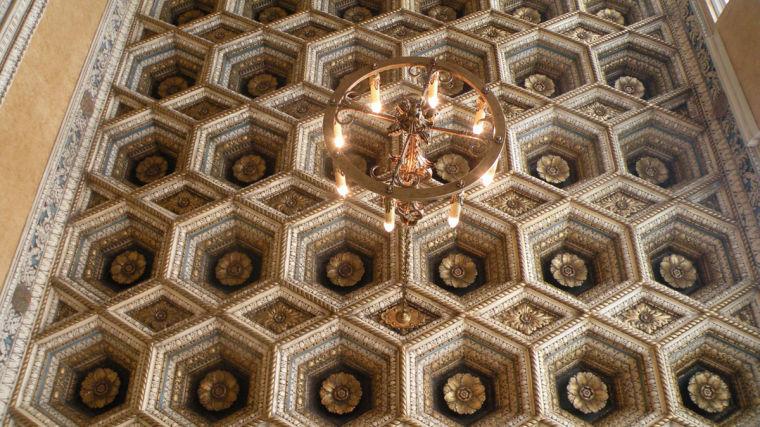Virginia Theater guided tours showcase building’s history and renovations
The chandelier and ceiling are both original to the Virginia Theater, which hosts weekly guided tours every Wednesday.
Jun 2, 2014
Last updated on May 8, 2016 at 03:15 a.m.
At a time when theaters ushered in large, eager crowds who came to watch live performances and movies frequently, a brand new theater opened its doors for the first time on Dec. 28, 1921. It was named the Virginia Theater, and it still stands today at 203 W. Park Ave. in Champaign.
Nearly 94 years after its original opening, the Virginia Theater has gone through renovations and passed between owners over the decades. Now the theater, which has been owned by the Champaign Park District since 2000, is hosting weekly guided tours of the building every Wednesday to educate visitors about its history.
Steven Bentz, director of the Virginia Theater, leads the tours.
He takes visitors through the lower-level and upper-level lobby areas, to the auditorium, the projection room, backstage and to the dressing rooms.
Get The Daily Illini in your inbox!
All the while, Bentz tells visitors about the theater’s history and explains the renovation project that was undertaken in 2000 with the goal of restoring the theater to its former glory after years of neglect.
The first performance held at the theater was called “The Bat,” which was a live show. The next night, the theater screened a movie, titled “The Boat.”
The News-Gazette had a “Special Virginia Theater Supplement” included in its Dec. 28, 1921 edition. It described the opening of the theater and called it “a Marvel of Design and Construction.” It also described the opening show of “The Bat,” as the “greatest play in generation.”
“From then on, it was mixed programming,” Bentz said. “We would open at 11 or 12 o’clock, there would be a live performance on stage, followed by a movie, followed by a little concert, followed by another live performance, followed by another choral event, followed by a movie — it would go for 12 hours. And that’s just because there was no television. People would go for entertainment at any point during the day. It was a really active space.”
Bentz said he believes the reason why the theater is still running is because of the flexibility with which it can run both movies and live performances.
Charlie Pyle came up with the idea for the theater and had plans drawn up for the building. He reached out to a man named A.W. Stoolman, a property developer in Champaign-Urbana. Stoolman agreed to help with the building under one condition: it be named after his daughter, Virginia.
It took 10 months to complete construction on the theater. The exterior of the building is Italian design, while the interior style is Spanish Renaissance revival. There is a coat of arms medallion in the upstairs lobby that references 10th century Spain, as well as crests repeated throughout the auditorium that also reflect Spanish influence.
The carpet that runs throughout the lobby was imported from Dublin during renovations.
“It’s our attempt to try and get as close as we could to the original design,” Bentz said. “We just had some records of it and were trying to provide a facsimile of it. It’s not an exact copy — it’s as close as we could get to the original.”
Stoolman owned the building from opening until 1969, leasing it to RKO Pictures, a big movie company in the ‘20s and ‘30s, from 1929 to 1968. GKC then took ownership from 1970 to the 1990s, before the Champaign Park District bought the theater.
“When we came in 2000, the place had been open continuously since 1921, but there’d really been no work … on it for 20 years,” Bentz said. “And there were huge issues: the air conditioning had to be redone, the pipes were all bad, the electrical was all bad, the basement would flood to about knee-height whenever it rained, some of the emergency exits were nailed shut.”
When the Champaign Park District took ownership, the theater lacked the original character it once had. Bentz said the auditorium had a “brown ceiling and mustard-yellow walls.”
“Everything we did in here was bringing it back to 1921 colors,” Bentz said.
He said that before renovations the lobby also had lost some of its former glory and ornate design, featuring white walls and ceilings, red carpet, and damaged plasterwork adorning the walls. Renovation projects recreated the plasterwork and added some of the original colors to the design of the theater.
“What the Park District is trying to do since we purchased (the Virginia Theater) in 2000 is just get it back to where it was in 1921, with modern amenities,” Bentz said. “But restore it to its former glory.”
Abrar can be reached at [email protected].






